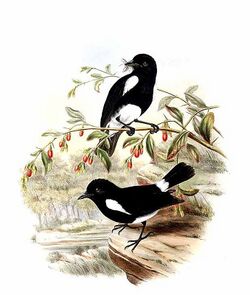Biology:White-rumped robin
| White-rumped robin | |
|---|---|

| |
| Scientific classification | |
| Domain: | Eukaryota |
| Kingdom: | Animalia |
| Phylum: | Chordata |
| Class: | Aves |
| Order: | Passeriformes |
| Family: | Petroicidae |
| Genus: | Peneothello |
| Species: | P. bimaculata
|
| Binomial name | |
| Peneothello bimaculata (Salvadori, 1874)
| |
The white-rumped robin (Peneothello bimaculata) is a species of bird in the family Petroicidae. It is found in New Guinea. Its natural habitats are subtropical or tropical moist lowland forests and subtropical or tropical moist montane forests.
Described by Italian naturalist Tommaso Salvadori in 1874, the white-rumped robin is a member of the Australasian robin family Petroicidae.[2][3] Sibley and Ahlquist's DNA-DNA hybridisation studies placed this group in a Corvida parvorder comprising many tropical and Australian passerines, including pardalotes, fairy-wrens, and honeyeaters, as well as crows.[4] However, subsequent molecular research (and current consensus) places the robins as a very early offshoot of the Passerida (or "advanced" songbirds) within the songbird lineage.[5]
Within the species, two subspecies are recognised: the nominate subspecies, which is found on the southern side of the main mountain range along New Guinea, and the subspecies vicarius of the Huon Peninsula and Adelbert Range.[6]
Description
Measuring 13 to 14 cm (5.1 to 5.5 in), the white-rumped robin has black plumage with a white rump and upper tail coverts. It has white patches on the sides of its breast. The abdomen is white in the nominate subspecies, and black with some white in the subspecies vicarius. The female closely resembles the male, but its black feathers have brown tinges. The bill and feet are black, and the eyes are dark brown.[6]
Distribution and habitat
The white-rumped robin is found in the highlands of New Guinea from altitudes of 300 to 1,700 m (980 to 5,580 ft). Within the rainforest it is found in pairs in the understory or on the ground. It is insectivorous.[6]
References
- ↑ BirdLife International (2016). "Peneothello bimaculata". IUCN Red List of Threatened Species 2016: e.T22704900A93990576. doi:10.2305/IUCN.UK.2016-3.RLTS.T22704900A93990576.en. https://www.iucnredlist.org/species/22704900/93990576. Retrieved 12 November 2021.
- ↑ * Boles, Walter E. (1988). The Robins and Flycatchers of Australia. Sydney: Angus & Robertson. p. 35. ISBN 0-207-15400-7.
- ↑ Gill, F. and D. Donsker, eds. (2020). IOC World Bird List (v 10.1). Doi 10.14344/IOC.ML.10.1. http://www.worldbirdnames.org/
- ↑ Phylogeny and Classification of Birds: A Study in Molecular Evolution. New Haven, CT: Yale University Press. 1990. pp. 603, 610–27. ISBN 0-300-04085-7.
- ↑ Barker, F. Keith; Cibois, Alice; Schikler, Peter A.; Feinstein, Julie; Cracraft, Joel (2004). "Phylogeny and diversification of the largest avian radiation". PNAS 101 (30): 11040–45. doi:10.1073/pnas.0401892101. PMID 15263073. PMC 503738. Bibcode: 2004PNAS..10111040B. http://www.pnas.org/cgi/reprint/0401892101v1.pdf. Retrieved 2008-08-14.
- ↑ 6.0 6.1 6.2 Coates, Brian J. (1990). The Birds of Papua New Guinea. Volume II. Queensland: Dove Publications. pp. 198–99. ISBN 978-0-9590257-1-2. OCLC 153651608.
Wikidata ☰ Q1587827 entry
 |


